Financial Accounting: Concept, Purpose and Reporting
VerifiedAdded on 2020/10/05
|19
|4339
|392
AI Summary
This assignment delves into the world of financial accounting, covering essential concepts, purposes, and reporting aspects. It discusses the significance of financial statements, including balance sheets, income statements, and cash flow statements. Additionally, it touches on the concept of depreciation and its role in financial reporting. The assignment also explores corporate financial accounting, highlighting its importance in decision-making for stakeholders. With a focus on managerial decision-making and the impact of financial information, this assignment provides a thorough understanding of financial accounting principles and practices.
Contribute Materials
Your contribution can guide someone’s learning journey. Share your
documents today.
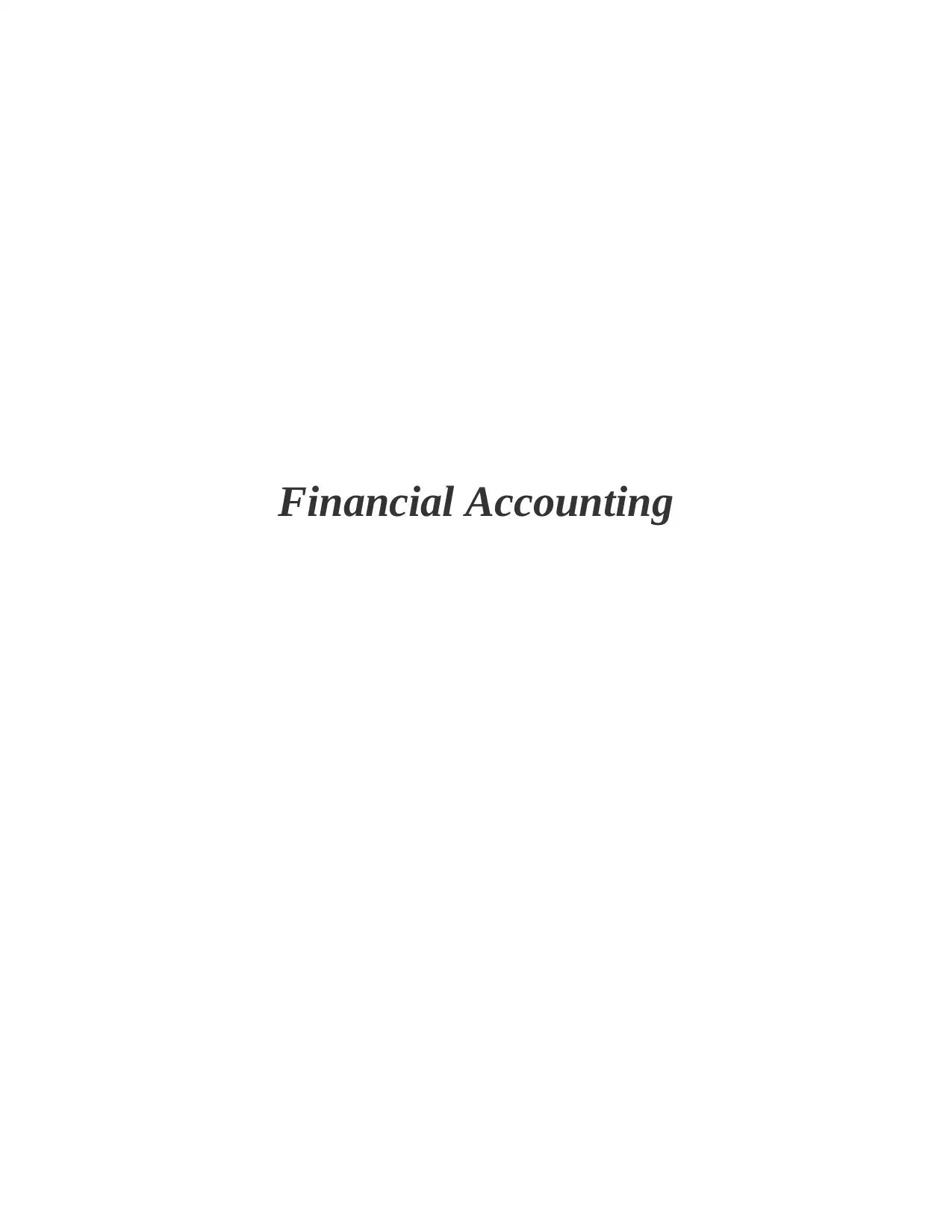
Financial Accounting
Secure Best Marks with AI Grader
Need help grading? Try our AI Grader for instant feedback on your assignments.
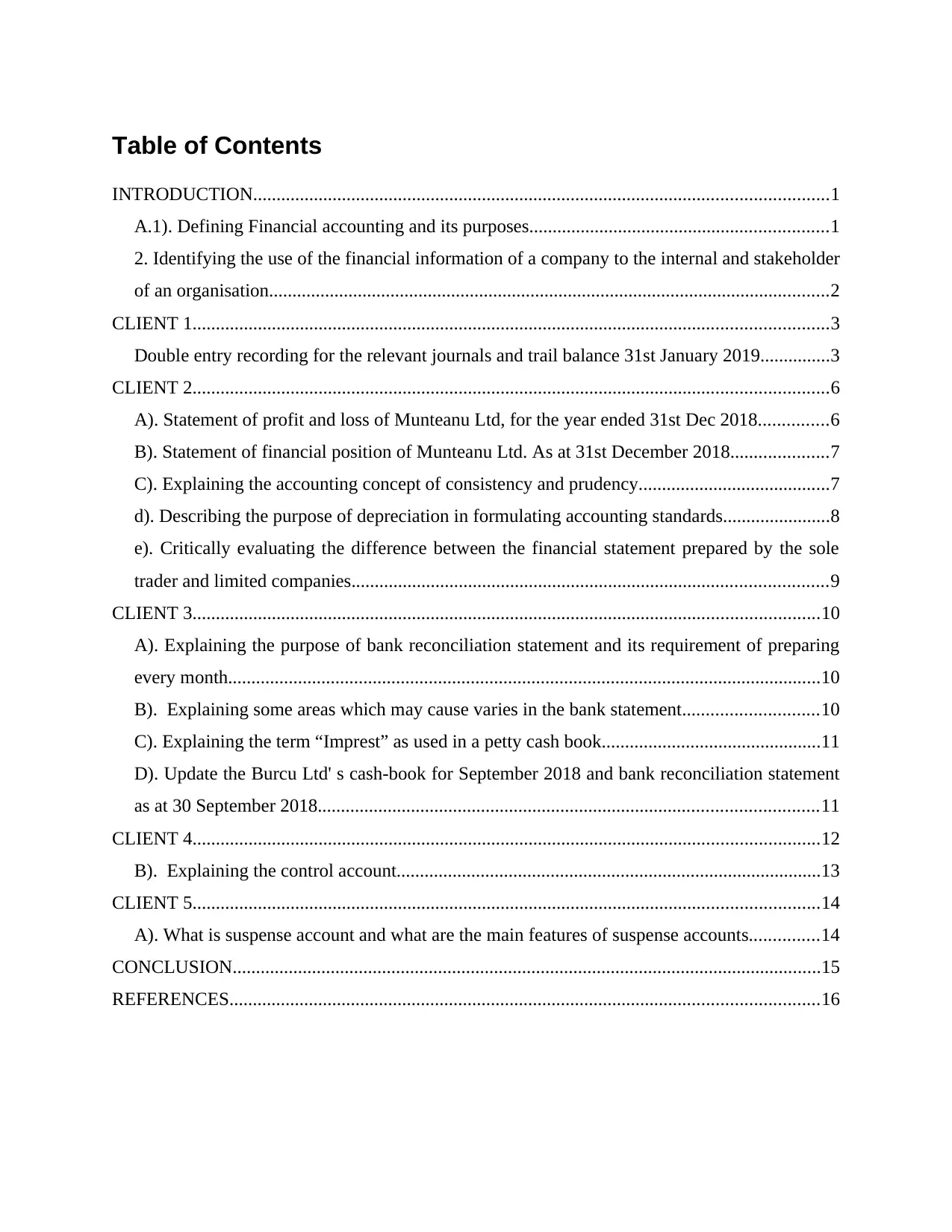
Table of Contents
INTRODUCTION...........................................................................................................................1
A.1). Defining Financial accounting and its purposes................................................................1
2. Identifying the use of the financial information of a company to the internal and stakeholder
of an organisation........................................................................................................................2
CLIENT 1........................................................................................................................................3
Double entry recording for the relevant journals and trail balance 31st January 2019...............3
CLIENT 2........................................................................................................................................6
A). Statement of profit and loss of Munteanu Ltd, for the year ended 31st Dec 2018...............6
B). Statement of financial position of Munteanu Ltd. As at 31st December 2018.....................7
C). Explaining the accounting concept of consistency and prudency.........................................7
d). Describing the purpose of depreciation in formulating accounting standards.......................8
e). Critically evaluating the difference between the financial statement prepared by the sole
trader and limited companies......................................................................................................9
CLIENT 3......................................................................................................................................10
A). Explaining the purpose of bank reconciliation statement and its requirement of preparing
every month...............................................................................................................................10
B). Explaining some areas which may cause varies in the bank statement.............................10
C). Explaining the term “Imprest” as used in a petty cash book...............................................11
D). Update the Burcu Ltd' s cash-book for September 2018 and bank reconciliation statement
as at 30 September 2018...........................................................................................................11
CLIENT 4......................................................................................................................................12
B). Explaining the control account...........................................................................................13
CLIENT 5......................................................................................................................................14
A). What is suspense account and what are the main features of suspense accounts...............14
CONCLUSION..............................................................................................................................15
REFERENCES..............................................................................................................................16
INTRODUCTION...........................................................................................................................1
A.1). Defining Financial accounting and its purposes................................................................1
2. Identifying the use of the financial information of a company to the internal and stakeholder
of an organisation........................................................................................................................2
CLIENT 1........................................................................................................................................3
Double entry recording for the relevant journals and trail balance 31st January 2019...............3
CLIENT 2........................................................................................................................................6
A). Statement of profit and loss of Munteanu Ltd, for the year ended 31st Dec 2018...............6
B). Statement of financial position of Munteanu Ltd. As at 31st December 2018.....................7
C). Explaining the accounting concept of consistency and prudency.........................................7
d). Describing the purpose of depreciation in formulating accounting standards.......................8
e). Critically evaluating the difference between the financial statement prepared by the sole
trader and limited companies......................................................................................................9
CLIENT 3......................................................................................................................................10
A). Explaining the purpose of bank reconciliation statement and its requirement of preparing
every month...............................................................................................................................10
B). Explaining some areas which may cause varies in the bank statement.............................10
C). Explaining the term “Imprest” as used in a petty cash book...............................................11
D). Update the Burcu Ltd' s cash-book for September 2018 and bank reconciliation statement
as at 30 September 2018...........................................................................................................11
CLIENT 4......................................................................................................................................12
B). Explaining the control account...........................................................................................13
CLIENT 5......................................................................................................................................14
A). What is suspense account and what are the main features of suspense accounts...............14
CONCLUSION..............................................................................................................................15
REFERENCES..............................................................................................................................16
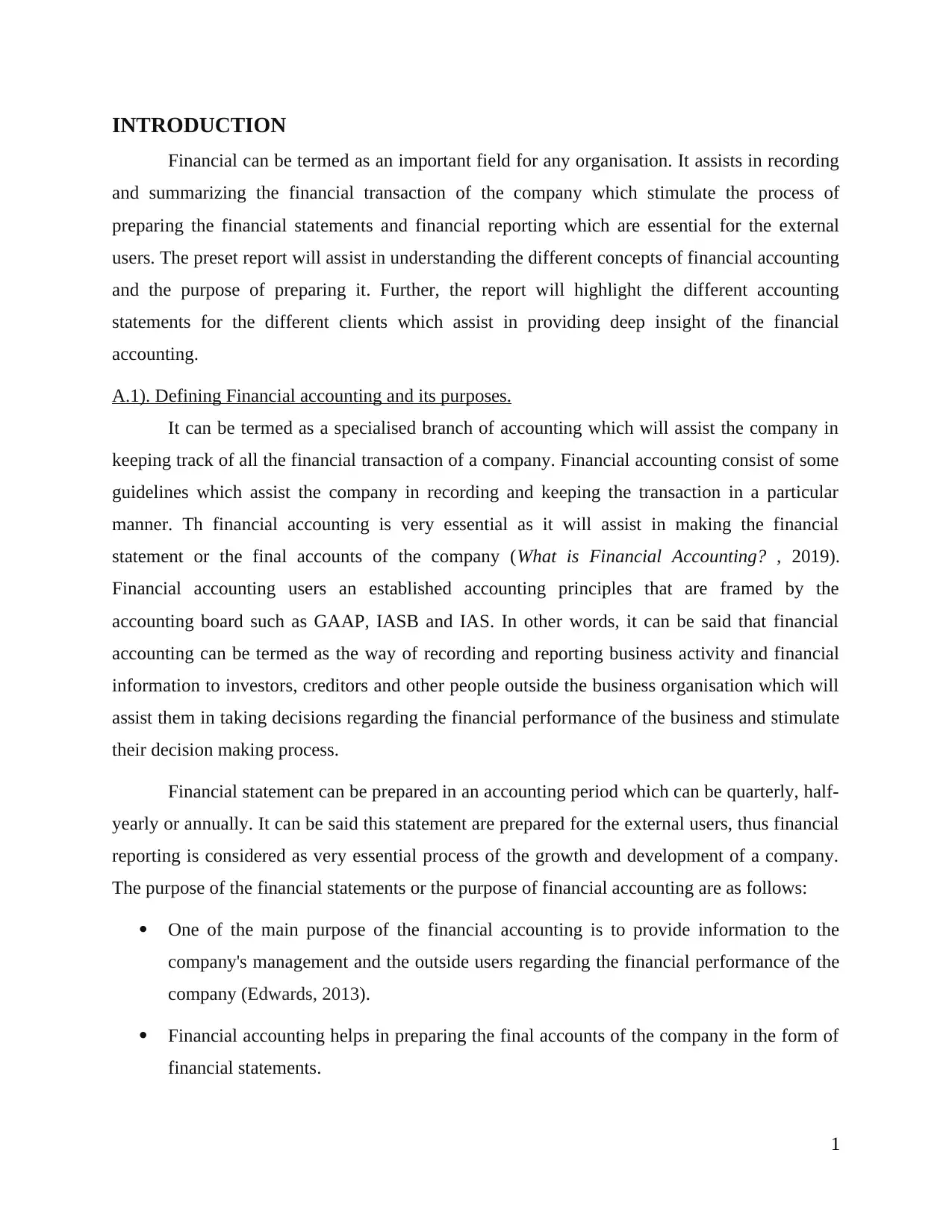
INTRODUCTION
Financial can be termed as an important field for any organisation. It assists in recording
and summarizing the financial transaction of the company which stimulate the process of
preparing the financial statements and financial reporting which are essential for the external
users. The preset report will assist in understanding the different concepts of financial accounting
and the purpose of preparing it. Further, the report will highlight the different accounting
statements for the different clients which assist in providing deep insight of the financial
accounting.
A.1). Defining Financial accounting and its purposes.
It can be termed as a specialised branch of accounting which will assist the company in
keeping track of all the financial transaction of a company. Financial accounting consist of some
guidelines which assist the company in recording and keeping the transaction in a particular
manner. Th financial accounting is very essential as it will assist in making the financial
statement or the final accounts of the company (What is Financial Accounting? , 2019).
Financial accounting users an established accounting principles that are framed by the
accounting board such as GAAP, IASB and IAS. In other words, it can be said that financial
accounting can be termed as the way of recording and reporting business activity and financial
information to investors, creditors and other people outside the business organisation which will
assist them in taking decisions regarding the financial performance of the business and stimulate
their decision making process.
Financial statement can be prepared in an accounting period which can be quarterly, half-
yearly or annually. It can be said this statement are prepared for the external users, thus financial
reporting is considered as very essential process of the growth and development of a company.
The purpose of the financial statements or the purpose of financial accounting are as follows:
One of the main purpose of the financial accounting is to provide information to the
company's management and the outside users regarding the financial performance of the
company (Edwards, 2013).
Financial accounting helps in preparing the final accounts of the company in the form of
financial statements.
1
Financial can be termed as an important field for any organisation. It assists in recording
and summarizing the financial transaction of the company which stimulate the process of
preparing the financial statements and financial reporting which are essential for the external
users. The preset report will assist in understanding the different concepts of financial accounting
and the purpose of preparing it. Further, the report will highlight the different accounting
statements for the different clients which assist in providing deep insight of the financial
accounting.
A.1). Defining Financial accounting and its purposes.
It can be termed as a specialised branch of accounting which will assist the company in
keeping track of all the financial transaction of a company. Financial accounting consist of some
guidelines which assist the company in recording and keeping the transaction in a particular
manner. Th financial accounting is very essential as it will assist in making the financial
statement or the final accounts of the company (What is Financial Accounting? , 2019).
Financial accounting users an established accounting principles that are framed by the
accounting board such as GAAP, IASB and IAS. In other words, it can be said that financial
accounting can be termed as the way of recording and reporting business activity and financial
information to investors, creditors and other people outside the business organisation which will
assist them in taking decisions regarding the financial performance of the business and stimulate
their decision making process.
Financial statement can be prepared in an accounting period which can be quarterly, half-
yearly or annually. It can be said this statement are prepared for the external users, thus financial
reporting is considered as very essential process of the growth and development of a company.
The purpose of the financial statements or the purpose of financial accounting are as follows:
One of the main purpose of the financial accounting is to provide information to the
company's management and the outside users regarding the financial performance of the
company (Edwards, 2013).
Financial accounting helps in preparing the final accounts of the company in the form of
financial statements.
1
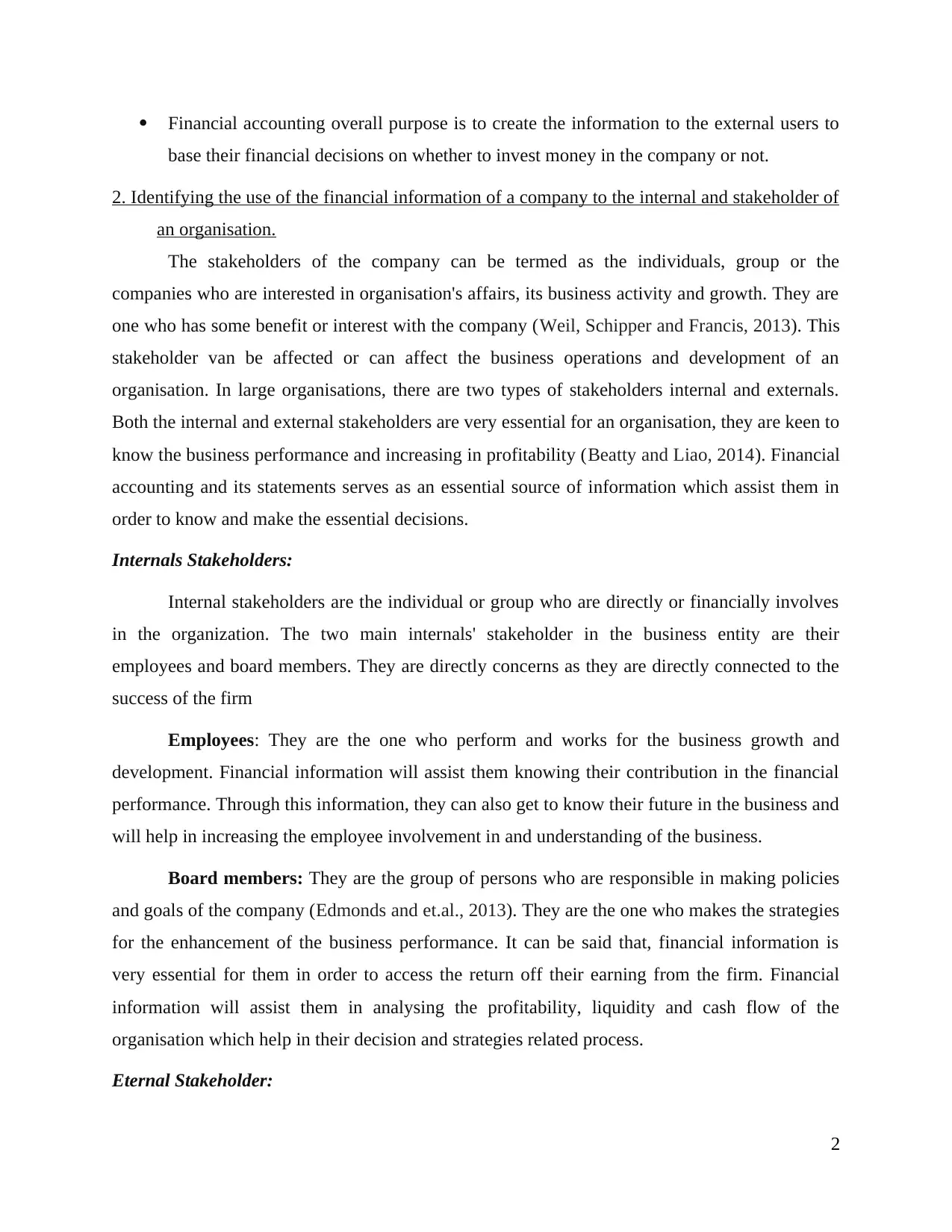
Financial accounting overall purpose is to create the information to the external users to
base their financial decisions on whether to invest money in the company or not.
2. Identifying the use of the financial information of a company to the internal and stakeholder of
an organisation.
The stakeholders of the company can be termed as the individuals, group or the
companies who are interested in organisation's affairs, its business activity and growth. They are
one who has some benefit or interest with the company (Weil, Schipper and Francis, 2013). This
stakeholder van be affected or can affect the business operations and development of an
organisation. In large organisations, there are two types of stakeholders internal and externals.
Both the internal and external stakeholders are very essential for an organisation, they are keen to
know the business performance and increasing in profitability (Beatty and Liao, 2014). Financial
accounting and its statements serves as an essential source of information which assist them in
order to know and make the essential decisions.
Internals Stakeholders:
Internal stakeholders are the individual or group who are directly or financially involves
in the organization. The two main internals' stakeholder in the business entity are their
employees and board members. They are directly concerns as they are directly connected to the
success of the firm
Employees: They are the one who perform and works for the business growth and
development. Financial information will assist them knowing their contribution in the financial
performance. Through this information, they can also get to know their future in the business and
will help in increasing the employee involvement in and understanding of the business.
Board members: They are the group of persons who are responsible in making policies
and goals of the company (Edmonds and et.al., 2013). They are the one who makes the strategies
for the enhancement of the business performance. It can be said that, financial information is
very essential for them in order to access the return off their earning from the firm. Financial
information will assist them in analysing the profitability, liquidity and cash flow of the
organisation which help in their decision and strategies related process.
Eternal Stakeholder:
2
base their financial decisions on whether to invest money in the company or not.
2. Identifying the use of the financial information of a company to the internal and stakeholder of
an organisation.
The stakeholders of the company can be termed as the individuals, group or the
companies who are interested in organisation's affairs, its business activity and growth. They are
one who has some benefit or interest with the company (Weil, Schipper and Francis, 2013). This
stakeholder van be affected or can affect the business operations and development of an
organisation. In large organisations, there are two types of stakeholders internal and externals.
Both the internal and external stakeholders are very essential for an organisation, they are keen to
know the business performance and increasing in profitability (Beatty and Liao, 2014). Financial
accounting and its statements serves as an essential source of information which assist them in
order to know and make the essential decisions.
Internals Stakeholders:
Internal stakeholders are the individual or group who are directly or financially involves
in the organization. The two main internals' stakeholder in the business entity are their
employees and board members. They are directly concerns as they are directly connected to the
success of the firm
Employees: They are the one who perform and works for the business growth and
development. Financial information will assist them knowing their contribution in the financial
performance. Through this information, they can also get to know their future in the business and
will help in increasing the employee involvement in and understanding of the business.
Board members: They are the group of persons who are responsible in making policies
and goals of the company (Edmonds and et.al., 2013). They are the one who makes the strategies
for the enhancement of the business performance. It can be said that, financial information is
very essential for them in order to access the return off their earning from the firm. Financial
information will assist them in analysing the profitability, liquidity and cash flow of the
organisation which help in their decision and strategies related process.
Eternal Stakeholder:
2
Secure Best Marks with AI Grader
Need help grading? Try our AI Grader for instant feedback on your assignments.
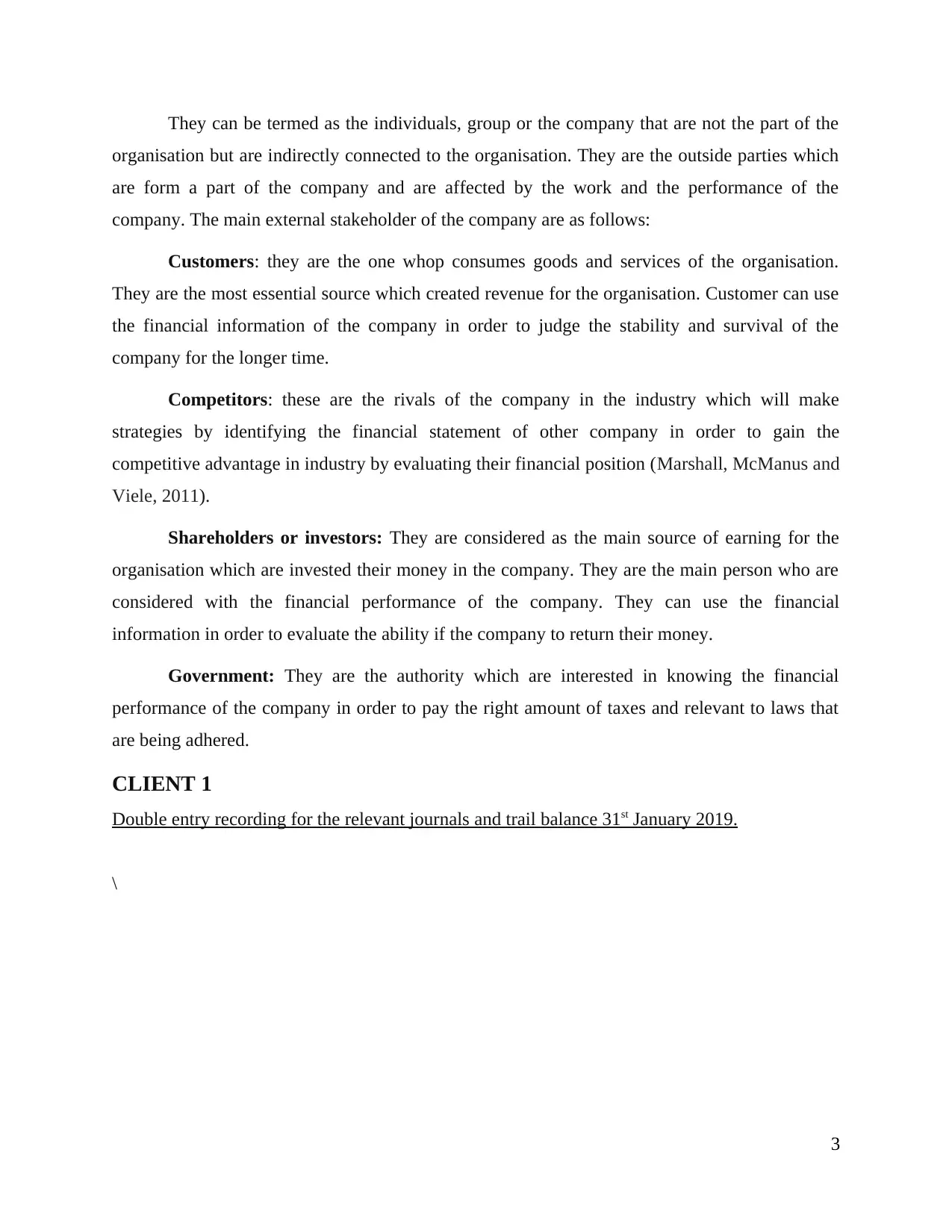
They can be termed as the individuals, group or the company that are not the part of the
organisation but are indirectly connected to the organisation. They are the outside parties which
are form a part of the company and are affected by the work and the performance of the
company. The main external stakeholder of the company are as follows:
Customers: they are the one whop consumes goods and services of the organisation.
They are the most essential source which created revenue for the organisation. Customer can use
the financial information of the company in order to judge the stability and survival of the
company for the longer time.
Competitors: these are the rivals of the company in the industry which will make
strategies by identifying the financial statement of other company in order to gain the
competitive advantage in industry by evaluating their financial position (Marshall, McManus and
Viele, 2011).
Shareholders or investors: They are considered as the main source of earning for the
organisation which are invested their money in the company. They are the main person who are
considered with the financial performance of the company. They can use the financial
information in order to evaluate the ability if the company to return their money.
Government: They are the authority which are interested in knowing the financial
performance of the company in order to pay the right amount of taxes and relevant to laws that
are being adhered.
CLIENT 1
Double entry recording for the relevant journals and trail balance 31st January 2019.
\
3
organisation but are indirectly connected to the organisation. They are the outside parties which
are form a part of the company and are affected by the work and the performance of the
company. The main external stakeholder of the company are as follows:
Customers: they are the one whop consumes goods and services of the organisation.
They are the most essential source which created revenue for the organisation. Customer can use
the financial information of the company in order to judge the stability and survival of the
company for the longer time.
Competitors: these are the rivals of the company in the industry which will make
strategies by identifying the financial statement of other company in order to gain the
competitive advantage in industry by evaluating their financial position (Marshall, McManus and
Viele, 2011).
Shareholders or investors: They are considered as the main source of earning for the
organisation which are invested their money in the company. They are the main person who are
considered with the financial performance of the company. They can use the financial
information in order to evaluate the ability if the company to return their money.
Government: They are the authority which are interested in knowing the financial
performance of the company in order to pay the right amount of taxes and relevant to laws that
are being adhered.
CLIENT 1
Double entry recording for the relevant journals and trail balance 31st January 2019.
\
3

4
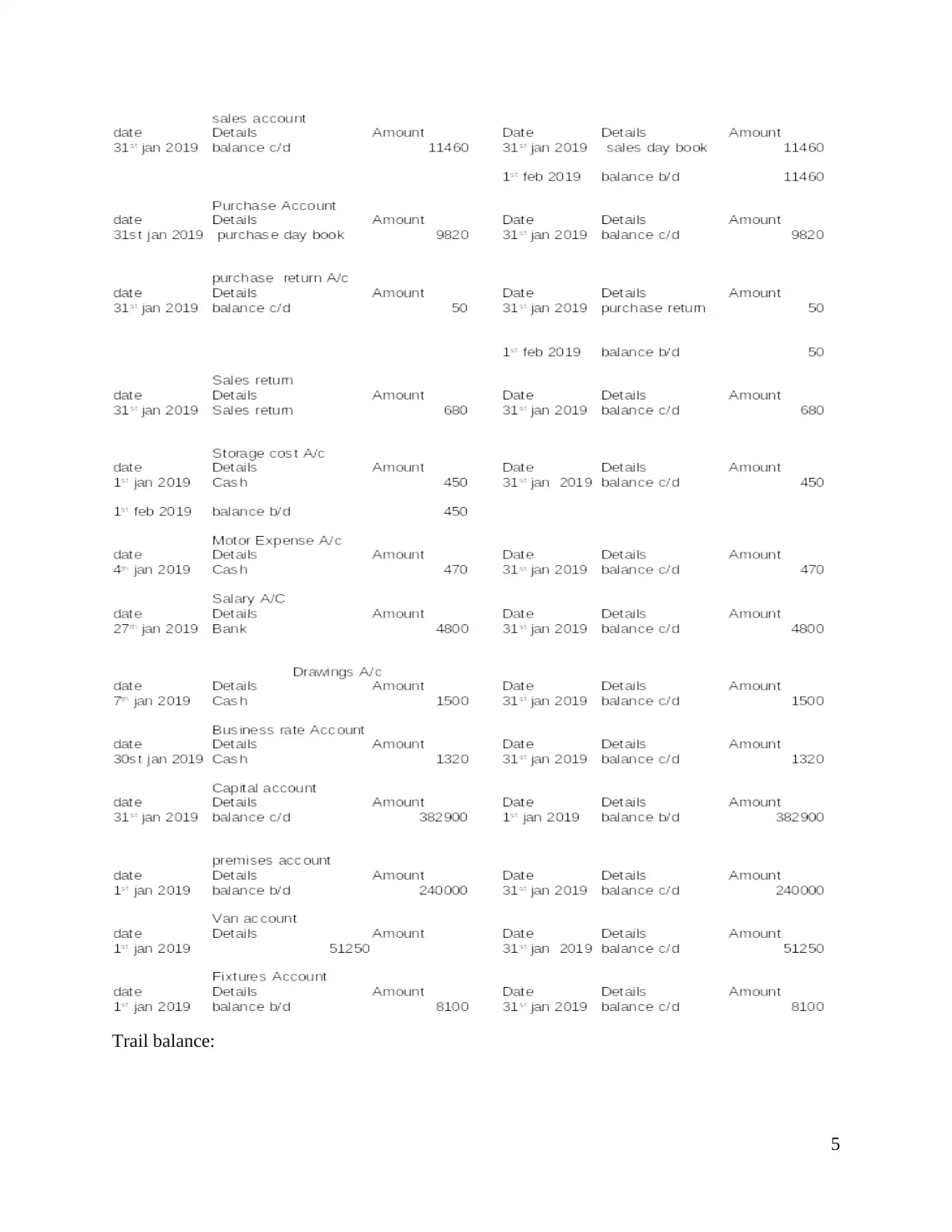
Trail balance:
5
5
Paraphrase This Document
Need a fresh take? Get an instant paraphrase of this document with our AI Paraphraser
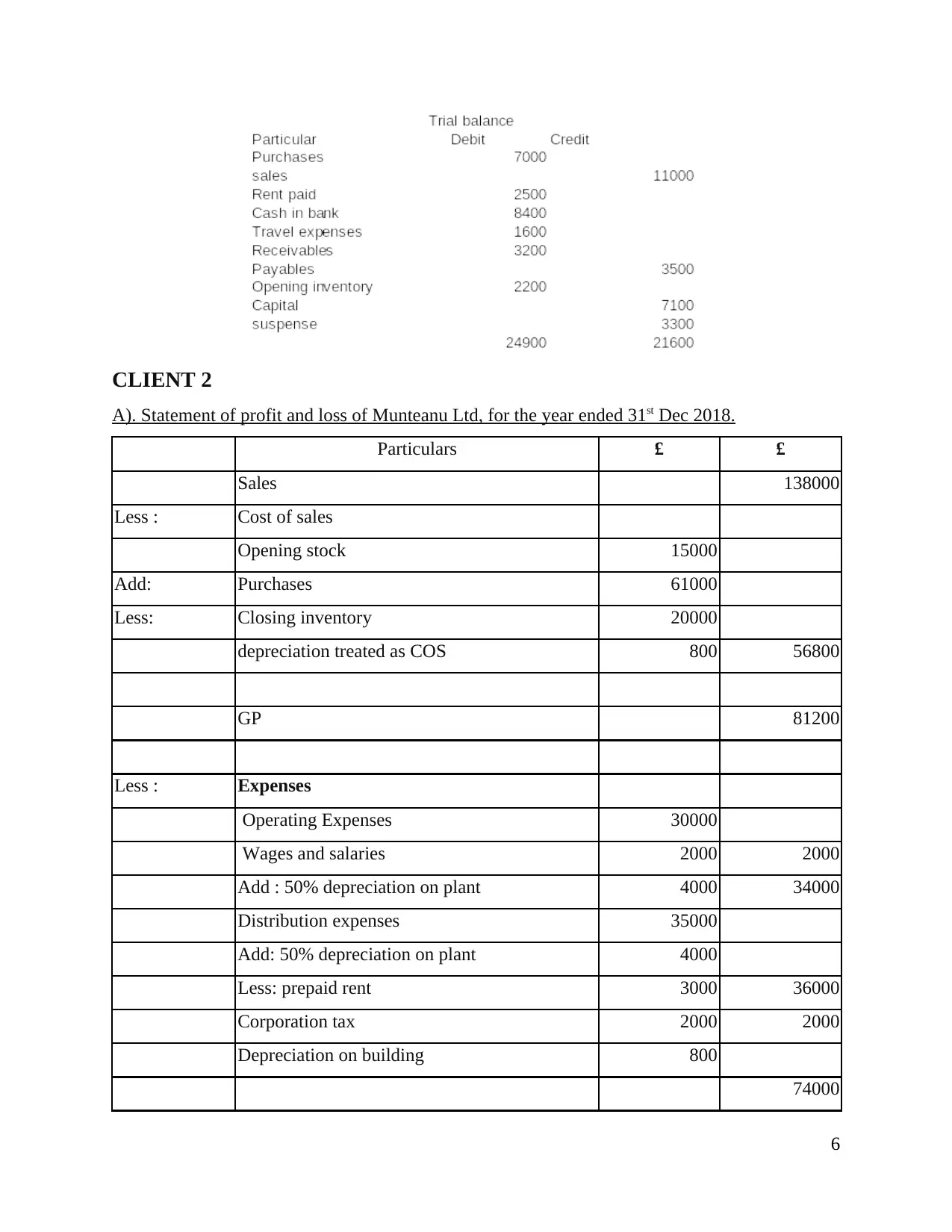
CLIENT 2
A). Statement of profit and loss of Munteanu Ltd, for the year ended 31st Dec 2018.
Particulars £ £
Sales 138000
Less : Cost of sales
Opening stock 15000
Add: Purchases 61000
Less: Closing inventory 20000
depreciation treated as COS 800 56800
GP 81200
Less : Expenses
Operating Expenses 30000
Wages and salaries 2000 2000
Add : 50% depreciation on plant 4000 34000
Distribution expenses 35000
Add: 50% depreciation on plant 4000
Less: prepaid rent 3000 36000
Corporation tax 2000 2000
Depreciation on building 800
74000
6
A). Statement of profit and loss of Munteanu Ltd, for the year ended 31st Dec 2018.
Particulars £ £
Sales 138000
Less : Cost of sales
Opening stock 15000
Add: Purchases 61000
Less: Closing inventory 20000
depreciation treated as COS 800 56800
GP 81200
Less : Expenses
Operating Expenses 30000
Wages and salaries 2000 2000
Add : 50% depreciation on plant 4000 34000
Distribution expenses 35000
Add: 50% depreciation on plant 4000
Less: prepaid rent 3000 36000
Corporation tax 2000 2000
Depreciation on building 800
74000
6
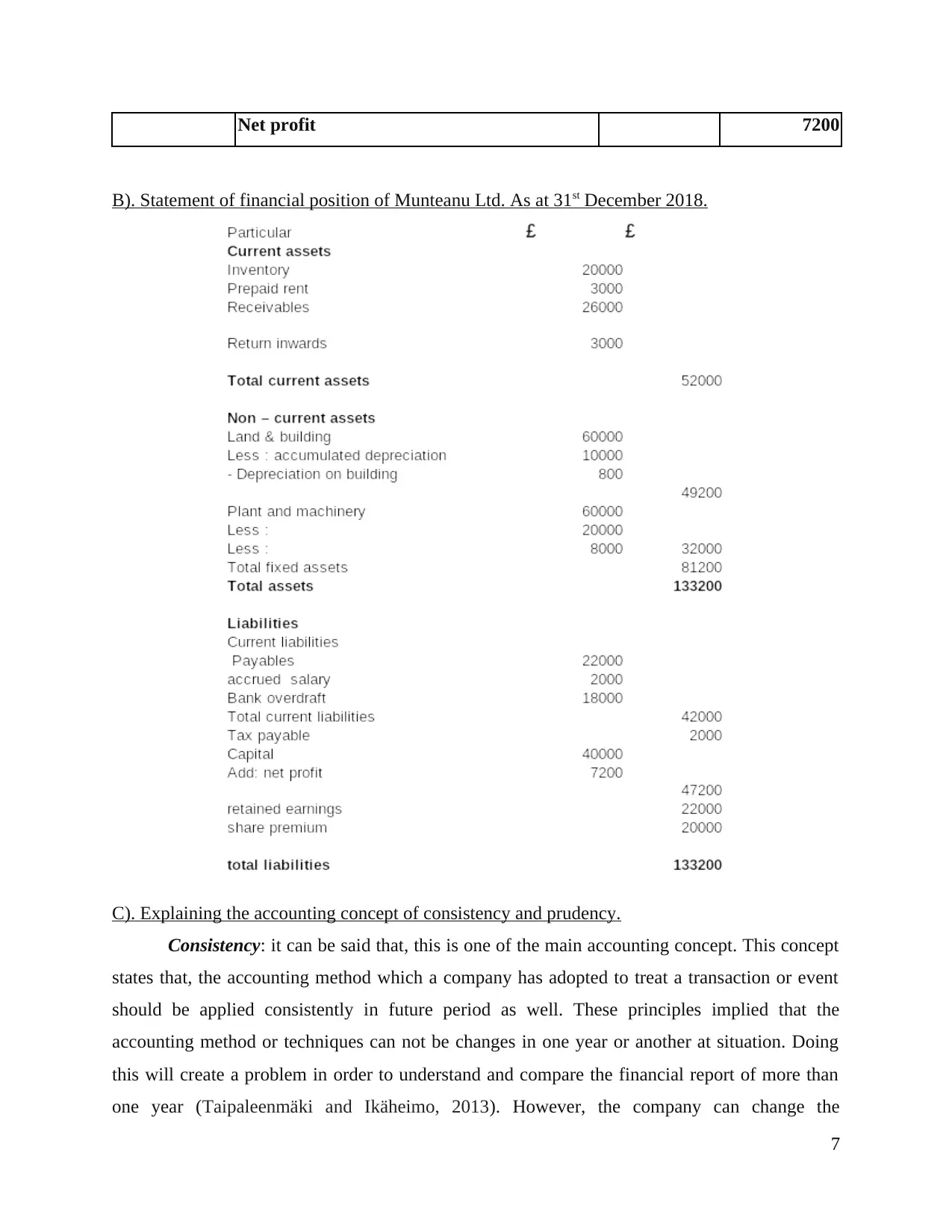
Net profit 7200
B). Statement of financial position of Munteanu Ltd. As at 31st December 2018.
C). Explaining the accounting concept of consistency and prudency.
Consistency: it can be said that, this is one of the main accounting concept. This concept
states that, the accounting method which a company has adopted to treat a transaction or event
should be applied consistently in future period as well. These principles implied that the
accounting method or techniques can not be changes in one year or another at situation. Doing
this will create a problem in order to understand and compare the financial report of more than
one year (Taipaleenmäki and Ikäheimo, 2013). However, the company can change the
7
B). Statement of financial position of Munteanu Ltd. As at 31st December 2018.
C). Explaining the accounting concept of consistency and prudency.
Consistency: it can be said that, this is one of the main accounting concept. This concept
states that, the accounting method which a company has adopted to treat a transaction or event
should be applied consistently in future period as well. These principles implied that the
accounting method or techniques can not be changes in one year or another at situation. Doing
this will create a problem in order to understand and compare the financial report of more than
one year (Taipaleenmäki and Ikäheimo, 2013). However, the company can change the
7
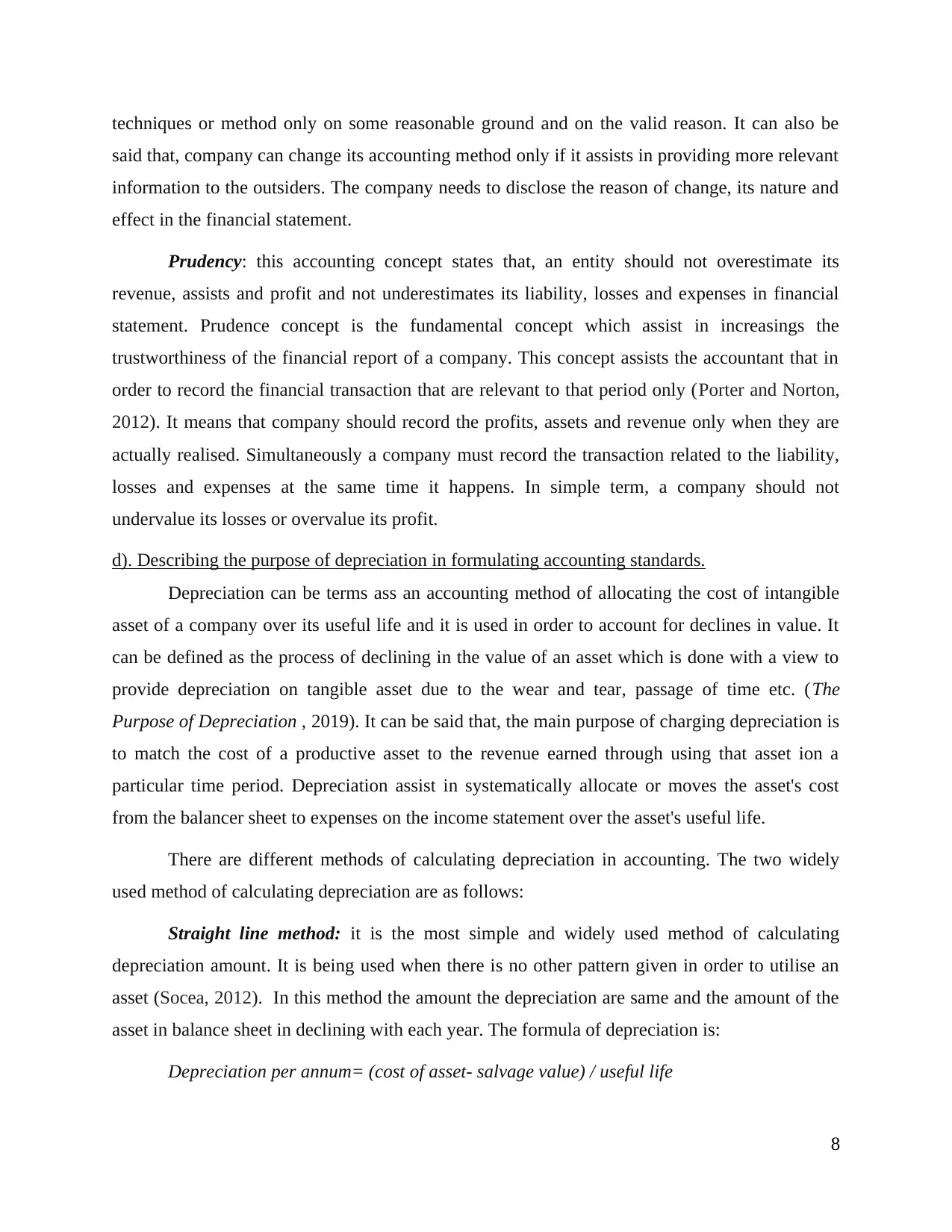
techniques or method only on some reasonable ground and on the valid reason. It can also be
said that, company can change its accounting method only if it assists in providing more relevant
information to the outsiders. The company needs to disclose the reason of change, its nature and
effect in the financial statement.
Prudency: this accounting concept states that, an entity should not overestimate its
revenue, assists and profit and not underestimates its liability, losses and expenses in financial
statement. Prudence concept is the fundamental concept which assist in increasings the
trustworthiness of the financial report of a company. This concept assists the accountant that in
order to record the financial transaction that are relevant to that period only (Porter and Norton,
2012). It means that company should record the profits, assets and revenue only when they are
actually realised. Simultaneously a company must record the transaction related to the liability,
losses and expenses at the same time it happens. In simple term, a company should not
undervalue its losses or overvalue its profit.
d). Describing the purpose of depreciation in formulating accounting standards.
Depreciation can be terms ass an accounting method of allocating the cost of intangible
asset of a company over its useful life and it is used in order to account for declines in value. It
can be defined as the process of declining in the value of an asset which is done with a view to
provide depreciation on tangible asset due to the wear and tear, passage of time etc. (The
Purpose of Depreciation , 2019). It can be said that, the main purpose of charging depreciation is
to match the cost of a productive asset to the revenue earned through using that asset ion a
particular time period. Depreciation assist in systematically allocate or moves the asset's cost
from the balancer sheet to expenses on the income statement over the asset's useful life.
There are different methods of calculating depreciation in accounting. The two widely
used method of calculating depreciation are as follows:
Straight line method: it is the most simple and widely used method of calculating
depreciation amount. It is being used when there is no other pattern given in order to utilise an
asset (Socea, 2012). In this method the amount the depreciation are same and the amount of the
asset in balance sheet in declining with each year. The formula of depreciation is:
Depreciation per annum= (cost of asset- salvage value) / useful life
8
said that, company can change its accounting method only if it assists in providing more relevant
information to the outsiders. The company needs to disclose the reason of change, its nature and
effect in the financial statement.
Prudency: this accounting concept states that, an entity should not overestimate its
revenue, assists and profit and not underestimates its liability, losses and expenses in financial
statement. Prudence concept is the fundamental concept which assist in increasings the
trustworthiness of the financial report of a company. This concept assists the accountant that in
order to record the financial transaction that are relevant to that period only (Porter and Norton,
2012). It means that company should record the profits, assets and revenue only when they are
actually realised. Simultaneously a company must record the transaction related to the liability,
losses and expenses at the same time it happens. In simple term, a company should not
undervalue its losses or overvalue its profit.
d). Describing the purpose of depreciation in formulating accounting standards.
Depreciation can be terms ass an accounting method of allocating the cost of intangible
asset of a company over its useful life and it is used in order to account for declines in value. It
can be defined as the process of declining in the value of an asset which is done with a view to
provide depreciation on tangible asset due to the wear and tear, passage of time etc. (The
Purpose of Depreciation , 2019). It can be said that, the main purpose of charging depreciation is
to match the cost of a productive asset to the revenue earned through using that asset ion a
particular time period. Depreciation assist in systematically allocate or moves the asset's cost
from the balancer sheet to expenses on the income statement over the asset's useful life.
There are different methods of calculating depreciation in accounting. The two widely
used method of calculating depreciation are as follows:
Straight line method: it is the most simple and widely used method of calculating
depreciation amount. It is being used when there is no other pattern given in order to utilise an
asset (Socea, 2012). In this method the amount the depreciation are same and the amount of the
asset in balance sheet in declining with each year. The formula of depreciation is:
Depreciation per annum= (cost of asset- salvage value) / useful life
8
Secure Best Marks with AI Grader
Need help grading? Try our AI Grader for instant feedback on your assignments.
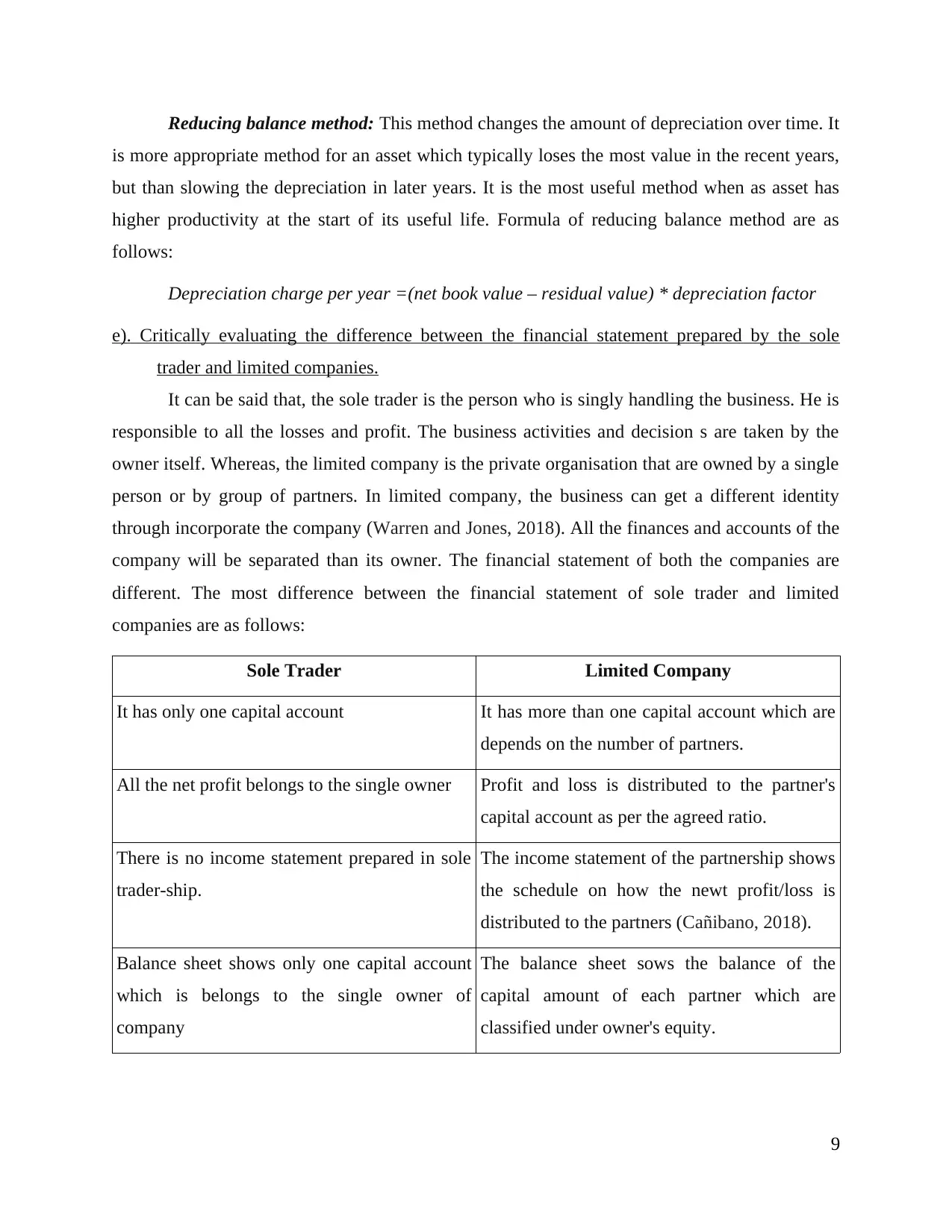
Reducing balance method: This method changes the amount of depreciation over time. It
is more appropriate method for an asset which typically loses the most value in the recent years,
but than slowing the depreciation in later years. It is the most useful method when as asset has
higher productivity at the start of its useful life. Formula of reducing balance method are as
follows:
Depreciation charge per year =(net book value – residual value) * depreciation factor
e). Critically evaluating the difference between the financial statement prepared by the sole
trader and limited companies.
It can be said that, the sole trader is the person who is singly handling the business. He is
responsible to all the losses and profit. The business activities and decision s are taken by the
owner itself. Whereas, the limited company is the private organisation that are owned by a single
person or by group of partners. In limited company, the business can get a different identity
through incorporate the company (Warren and Jones, 2018). All the finances and accounts of the
company will be separated than its owner. The financial statement of both the companies are
different. The most difference between the financial statement of sole trader and limited
companies are as follows:
Sole Trader Limited Company
It has only one capital account It has more than one capital account which are
depends on the number of partners.
All the net profit belongs to the single owner Profit and loss is distributed to the partner's
capital account as per the agreed ratio.
There is no income statement prepared in sole
trader-ship.
The income statement of the partnership shows
the schedule on how the newt profit/loss is
distributed to the partners (Cañibano, 2018).
Balance sheet shows only one capital account
which is belongs to the single owner of
company
The balance sheet sows the balance of the
capital amount of each partner which are
classified under owner's equity.
9
is more appropriate method for an asset which typically loses the most value in the recent years,
but than slowing the depreciation in later years. It is the most useful method when as asset has
higher productivity at the start of its useful life. Formula of reducing balance method are as
follows:
Depreciation charge per year =(net book value – residual value) * depreciation factor
e). Critically evaluating the difference between the financial statement prepared by the sole
trader and limited companies.
It can be said that, the sole trader is the person who is singly handling the business. He is
responsible to all the losses and profit. The business activities and decision s are taken by the
owner itself. Whereas, the limited company is the private organisation that are owned by a single
person or by group of partners. In limited company, the business can get a different identity
through incorporate the company (Warren and Jones, 2018). All the finances and accounts of the
company will be separated than its owner. The financial statement of both the companies are
different. The most difference between the financial statement of sole trader and limited
companies are as follows:
Sole Trader Limited Company
It has only one capital account It has more than one capital account which are
depends on the number of partners.
All the net profit belongs to the single owner Profit and loss is distributed to the partner's
capital account as per the agreed ratio.
There is no income statement prepared in sole
trader-ship.
The income statement of the partnership shows
the schedule on how the newt profit/loss is
distributed to the partners (Cañibano, 2018).
Balance sheet shows only one capital account
which is belongs to the single owner of
company
The balance sheet sows the balance of the
capital amount of each partner which are
classified under owner's equity.
9
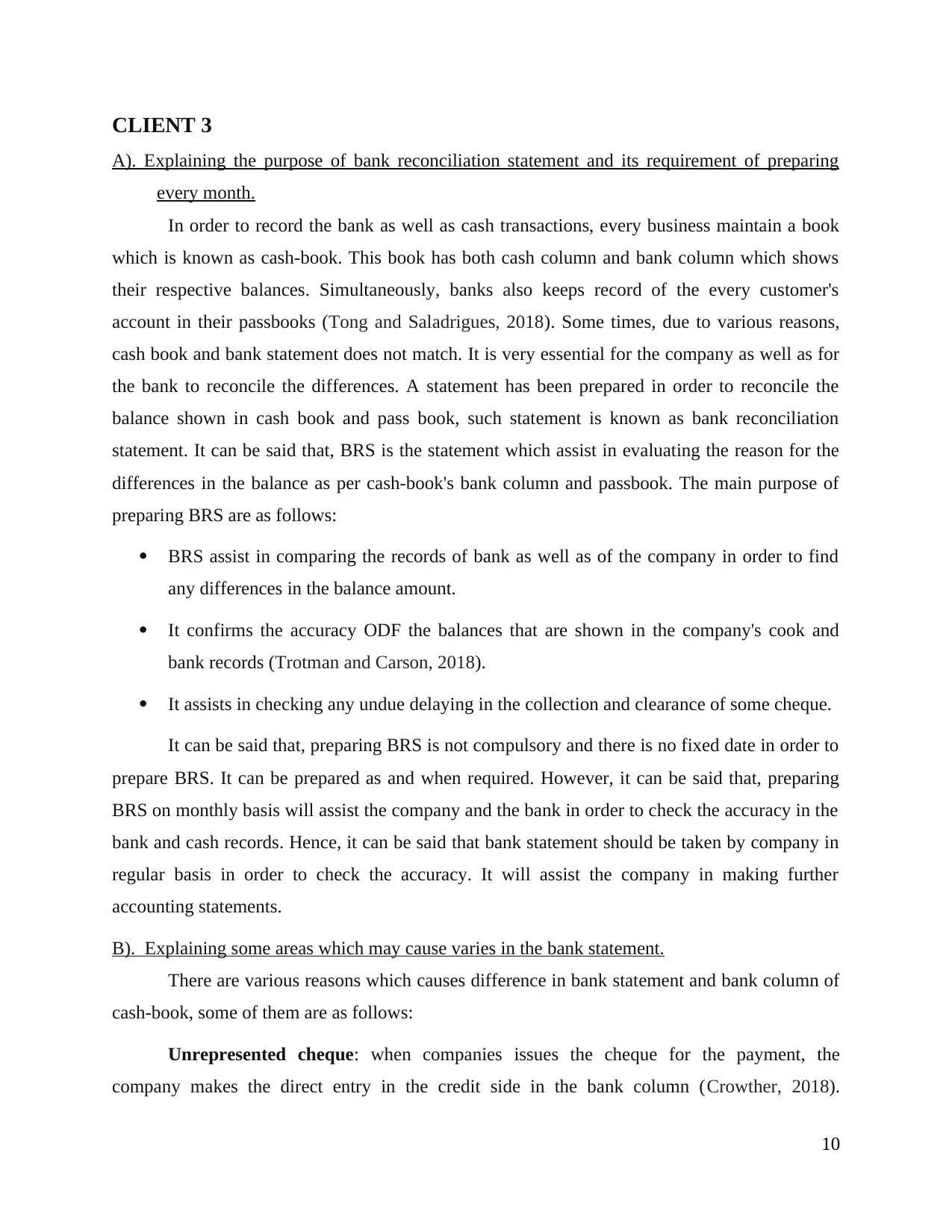
CLIENT 3
A). Explaining the purpose of bank reconciliation statement and its requirement of preparing
every month.
In order to record the bank as well as cash transactions, every business maintain a book
which is known as cash-book. This book has both cash column and bank column which shows
their respective balances. Simultaneously, banks also keeps record of the every customer's
account in their passbooks (Tong and Saladrigues, 2018). Some times, due to various reasons,
cash book and bank statement does not match. It is very essential for the company as well as for
the bank to reconcile the differences. A statement has been prepared in order to reconcile the
balance shown in cash book and pass book, such statement is known as bank reconciliation
statement. It can be said that, BRS is the statement which assist in evaluating the reason for the
differences in the balance as per cash-book's bank column and passbook. The main purpose of
preparing BRS are as follows:
BRS assist in comparing the records of bank as well as of the company in order to find
any differences in the balance amount.
It confirms the accuracy ODF the balances that are shown in the company's cook and
bank records (Trotman and Carson, 2018).
It assists in checking any undue delaying in the collection and clearance of some cheque.
It can be said that, preparing BRS is not compulsory and there is no fixed date in order to
prepare BRS. It can be prepared as and when required. However, it can be said that, preparing
BRS on monthly basis will assist the company and the bank in order to check the accuracy in the
bank and cash records. Hence, it can be said that bank statement should be taken by company in
regular basis in order to check the accuracy. It will assist the company in making further
accounting statements.
B). Explaining some areas which may cause varies in the bank statement.
There are various reasons which causes difference in bank statement and bank column of
cash-book, some of them are as follows:
Unrepresented cheque: when companies issues the cheque for the payment, the
company makes the direct entry in the credit side in the bank column (Crowther, 2018).
10
A). Explaining the purpose of bank reconciliation statement and its requirement of preparing
every month.
In order to record the bank as well as cash transactions, every business maintain a book
which is known as cash-book. This book has both cash column and bank column which shows
their respective balances. Simultaneously, banks also keeps record of the every customer's
account in their passbooks (Tong and Saladrigues, 2018). Some times, due to various reasons,
cash book and bank statement does not match. It is very essential for the company as well as for
the bank to reconcile the differences. A statement has been prepared in order to reconcile the
balance shown in cash book and pass book, such statement is known as bank reconciliation
statement. It can be said that, BRS is the statement which assist in evaluating the reason for the
differences in the balance as per cash-book's bank column and passbook. The main purpose of
preparing BRS are as follows:
BRS assist in comparing the records of bank as well as of the company in order to find
any differences in the balance amount.
It confirms the accuracy ODF the balances that are shown in the company's cook and
bank records (Trotman and Carson, 2018).
It assists in checking any undue delaying in the collection and clearance of some cheque.
It can be said that, preparing BRS is not compulsory and there is no fixed date in order to
prepare BRS. It can be prepared as and when required. However, it can be said that, preparing
BRS on monthly basis will assist the company and the bank in order to check the accuracy in the
bank and cash records. Hence, it can be said that bank statement should be taken by company in
regular basis in order to check the accuracy. It will assist the company in making further
accounting statements.
B). Explaining some areas which may cause varies in the bank statement.
There are various reasons which causes difference in bank statement and bank column of
cash-book, some of them are as follows:
Unrepresented cheque: when companies issues the cheque for the payment, the
company makes the direct entry in the credit side in the bank column (Crowther, 2018).
10
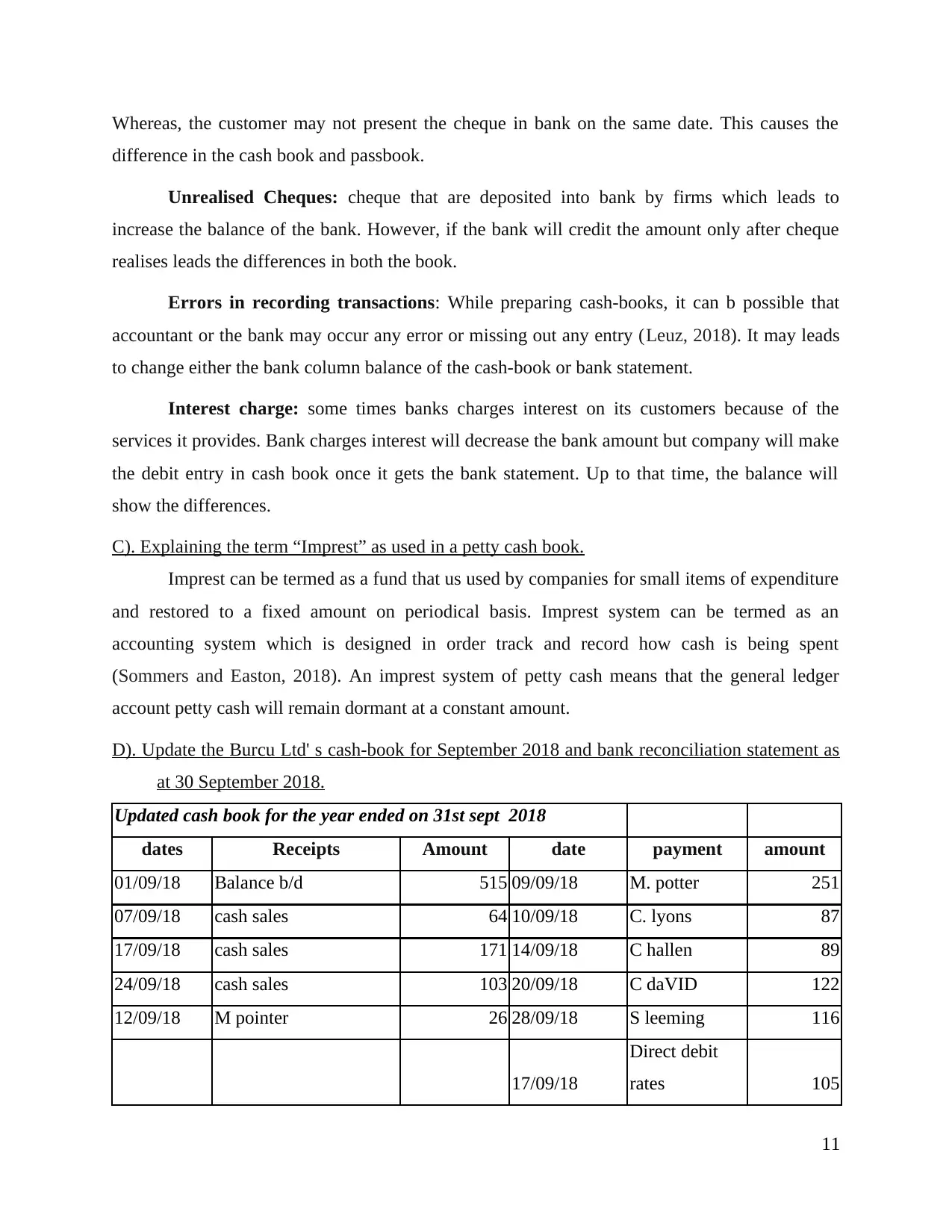
Whereas, the customer may not present the cheque in bank on the same date. This causes the
difference in the cash book and passbook.
Unrealised Cheques: cheque that are deposited into bank by firms which leads to
increase the balance of the bank. However, if the bank will credit the amount only after cheque
realises leads the differences in both the book.
Errors in recording transactions: While preparing cash-books, it can b possible that
accountant or the bank may occur any error or missing out any entry (Leuz, 2018). It may leads
to change either the bank column balance of the cash-book or bank statement.
Interest charge: some times banks charges interest on its customers because of the
services it provides. Bank charges interest will decrease the bank amount but company will make
the debit entry in cash book once it gets the bank statement. Up to that time, the balance will
show the differences.
C). Explaining the term “Imprest” as used in a petty cash book.
Imprest can be termed as a fund that us used by companies for small items of expenditure
and restored to a fixed amount on periodical basis. Imprest system can be termed as an
accounting system which is designed in order track and record how cash is being spent
(Sommers and Easton, 2018). An imprest system of petty cash means that the general ledger
account petty cash will remain dormant at a constant amount.
D). Update the Burcu Ltd' s cash-book for September 2018 and bank reconciliation statement as
at 30 September 2018.
Updated cash book for the year ended on 31st sept 2018
dates Receipts Amount date payment amount
01/09/18 Balance b/d 515 09/09/18 M. potter 251
07/09/18 cash sales 64 10/09/18 C. lyons 87
17/09/18 cash sales 171 14/09/18 C hallen 89
24/09/18 cash sales 103 20/09/18 C daVID 122
12/09/18 M pointer 26 28/09/18 S leeming 116
17/09/18
Direct debit
rates 105
11
difference in the cash book and passbook.
Unrealised Cheques: cheque that are deposited into bank by firms which leads to
increase the balance of the bank. However, if the bank will credit the amount only after cheque
realises leads the differences in both the book.
Errors in recording transactions: While preparing cash-books, it can b possible that
accountant or the bank may occur any error or missing out any entry (Leuz, 2018). It may leads
to change either the bank column balance of the cash-book or bank statement.
Interest charge: some times banks charges interest on its customers because of the
services it provides. Bank charges interest will decrease the bank amount but company will make
the debit entry in cash book once it gets the bank statement. Up to that time, the balance will
show the differences.
C). Explaining the term “Imprest” as used in a petty cash book.
Imprest can be termed as a fund that us used by companies for small items of expenditure
and restored to a fixed amount on periodical basis. Imprest system can be termed as an
accounting system which is designed in order track and record how cash is being spent
(Sommers and Easton, 2018). An imprest system of petty cash means that the general ledger
account petty cash will remain dormant at a constant amount.
D). Update the Burcu Ltd' s cash-book for September 2018 and bank reconciliation statement as
at 30 September 2018.
Updated cash book for the year ended on 31st sept 2018
dates Receipts Amount date payment amount
01/09/18 Balance b/d 515 09/09/18 M. potter 251
07/09/18 cash sales 64 10/09/18 C. lyons 87
17/09/18 cash sales 171 14/09/18 C hallen 89
24/09/18 cash sales 103 20/09/18 C daVID 122
12/09/18 M pointer 26 28/09/18 S leeming 116
17/09/18
Direct debit
rates 105
11
Paraphrase This Document
Need a fresh take? Get an instant paraphrase of this document with our AI Paraphraser
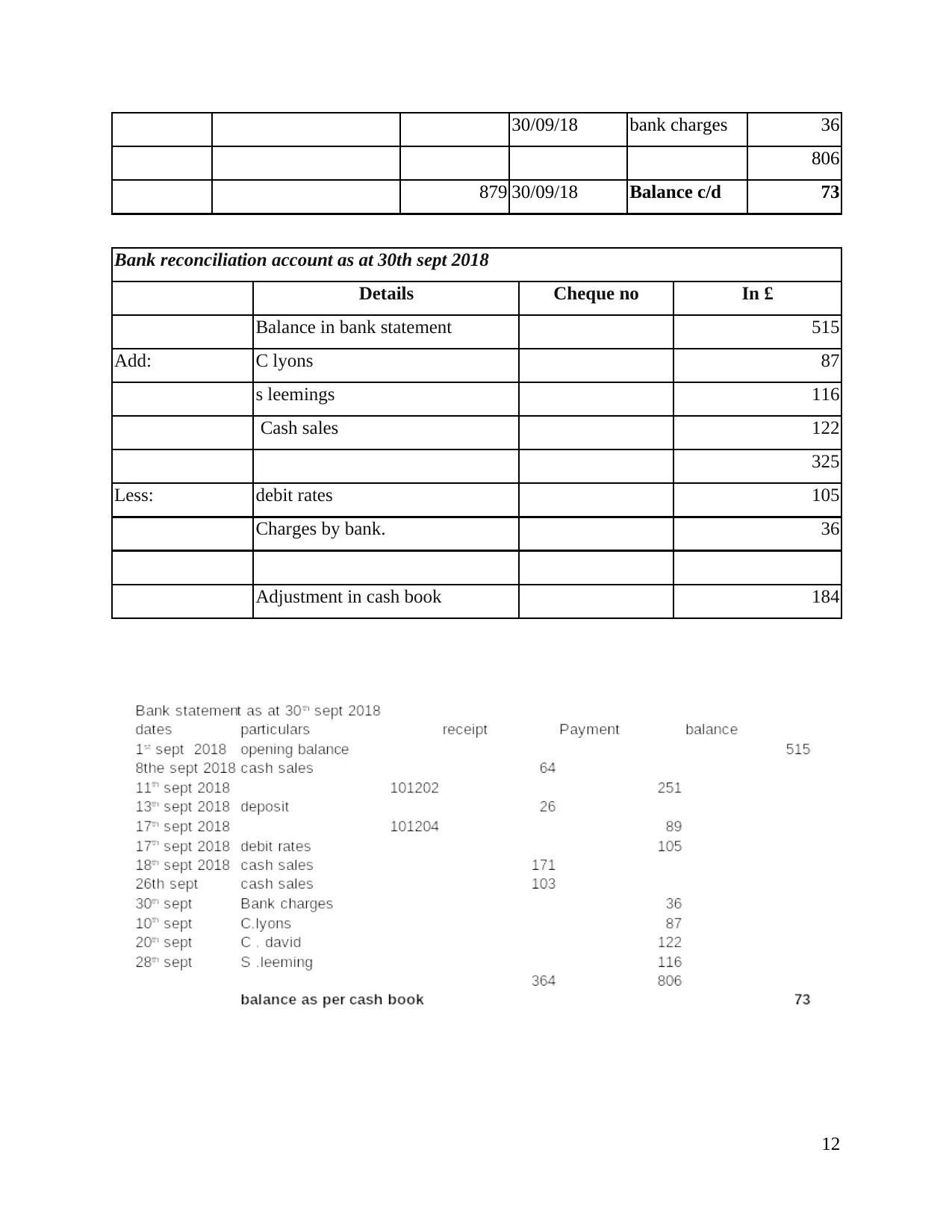
30/09/18 bank charges 36
806
879 30/09/18 Balance c/d 73
Bank reconciliation account as at 30th sept 2018
Details Cheque no In £
Balance in bank statement 515
Add: C lyons 87
s leemings 116
Cash sales 122
325
Less: debit rates 105
Charges by bank. 36
Adjustment in cash book 184
12
806
879 30/09/18 Balance c/d 73
Bank reconciliation account as at 30th sept 2018
Details Cheque no In £
Balance in bank statement 515
Add: C lyons 87
s leemings 116
Cash sales 122
325
Less: debit rates 105
Charges by bank. 36
Adjustment in cash book 184
12
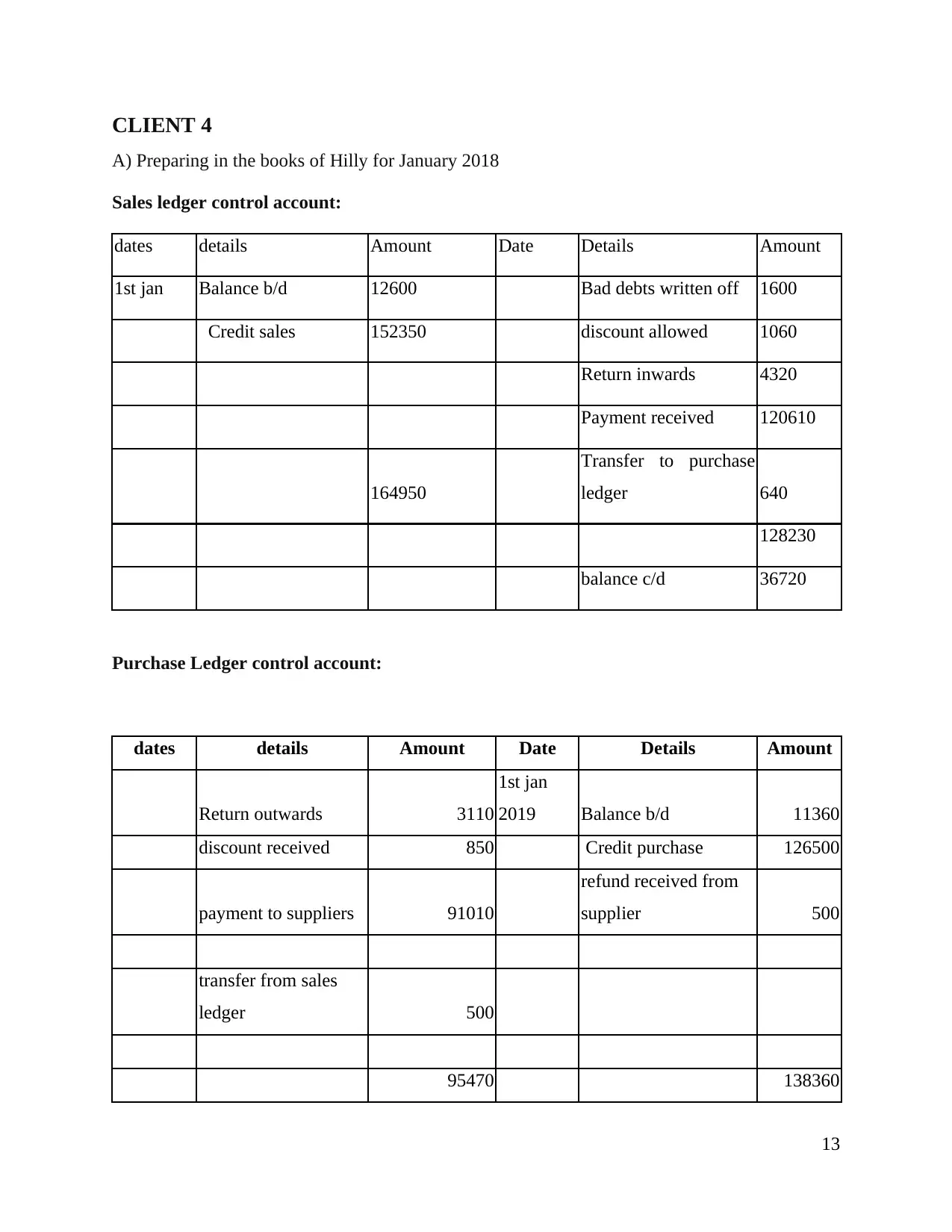
CLIENT 4
A) Preparing in the books of Hilly for January 2018
Sales ledger control account:
dates details Amount Date Details Amount
1st jan Balance b/d 12600 Bad debts written off 1600
Credit sales 152350 discount allowed 1060
Return inwards 4320
Payment received 120610
164950
Transfer to purchase
ledger 640
128230
balance c/d 36720
Purchase Ledger control account:
dates details Amount Date Details Amount
Return outwards 3110
1st jan
2019 Balance b/d 11360
discount received 850 Credit purchase 126500
payment to suppliers 91010
refund received from
supplier 500
transfer from sales
ledger 500
95470 138360
13
A) Preparing in the books of Hilly for January 2018
Sales ledger control account:
dates details Amount Date Details Amount
1st jan Balance b/d 12600 Bad debts written off 1600
Credit sales 152350 discount allowed 1060
Return inwards 4320
Payment received 120610
164950
Transfer to purchase
ledger 640
128230
balance c/d 36720
Purchase Ledger control account:
dates details Amount Date Details Amount
Return outwards 3110
1st jan
2019 Balance b/d 11360
discount received 850 Credit purchase 126500
payment to suppliers 91010
refund received from
supplier 500
transfer from sales
ledger 500
95470 138360
13
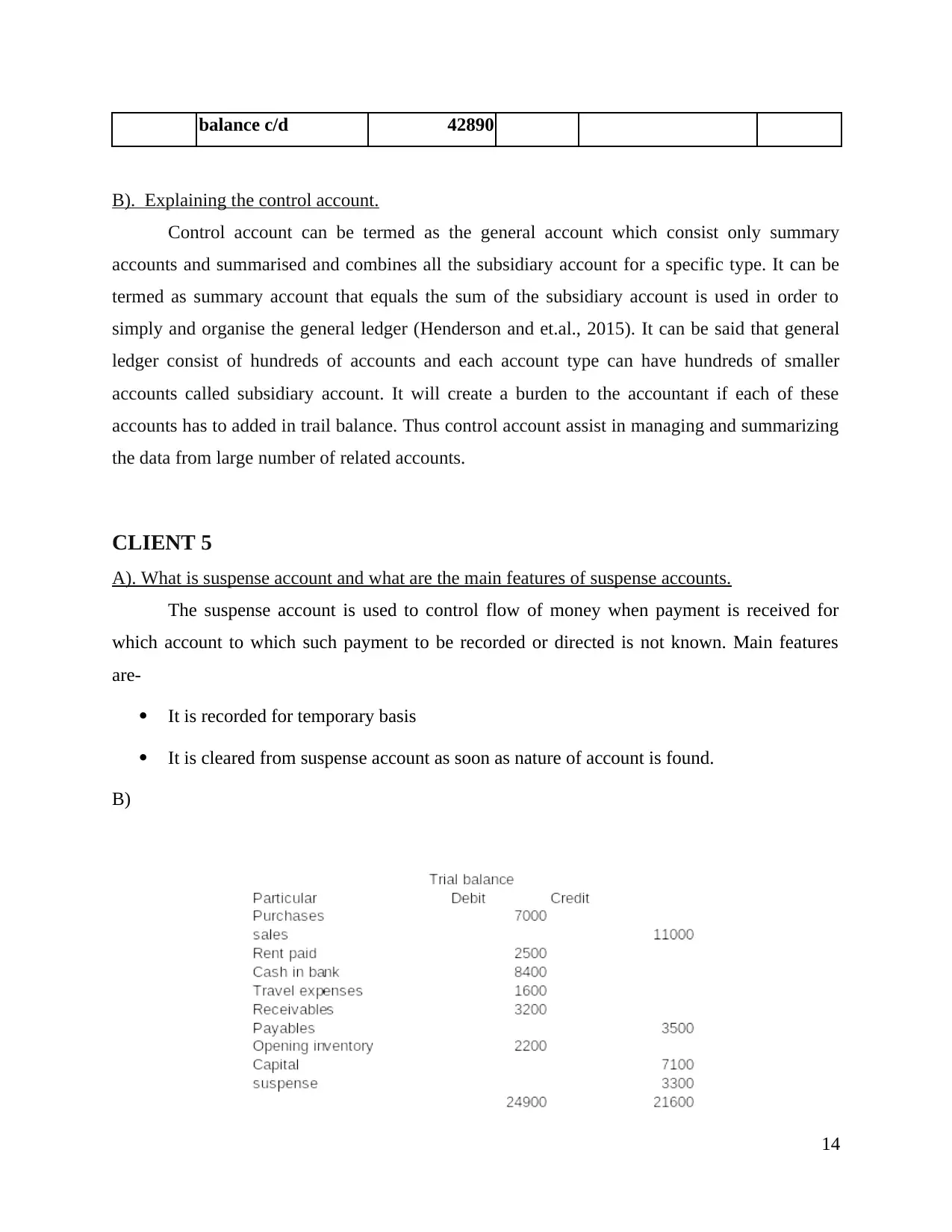
balance c/d 42890
B). Explaining the control account.
Control account can be termed as the general account which consist only summary
accounts and summarised and combines all the subsidiary account for a specific type. It can be
termed as summary account that equals the sum of the subsidiary account is used in order to
simply and organise the general ledger (Henderson and et.al., 2015). It can be said that general
ledger consist of hundreds of accounts and each account type can have hundreds of smaller
accounts called subsidiary account. It will create a burden to the accountant if each of these
accounts has to added in trail balance. Thus control account assist in managing and summarizing
the data from large number of related accounts.
CLIENT 5
A). What is suspense account and what are the main features of suspense accounts.
The suspense account is used to control flow of money when payment is received for
which account to which such payment to be recorded or directed is not known. Main features
are-
It is recorded for temporary basis
It is cleared from suspense account as soon as nature of account is found.
B)
14
B). Explaining the control account.
Control account can be termed as the general account which consist only summary
accounts and summarised and combines all the subsidiary account for a specific type. It can be
termed as summary account that equals the sum of the subsidiary account is used in order to
simply and organise the general ledger (Henderson and et.al., 2015). It can be said that general
ledger consist of hundreds of accounts and each account type can have hundreds of smaller
accounts called subsidiary account. It will create a burden to the accountant if each of these
accounts has to added in trail balance. Thus control account assist in managing and summarizing
the data from large number of related accounts.
CLIENT 5
A). What is suspense account and what are the main features of suspense accounts.
The suspense account is used to control flow of money when payment is received for
which account to which such payment to be recorded or directed is not known. Main features
are-
It is recorded for temporary basis
It is cleared from suspense account as soon as nature of account is found.
B)
14
Secure Best Marks with AI Grader
Need help grading? Try our AI Grader for instant feedback on your assignments.
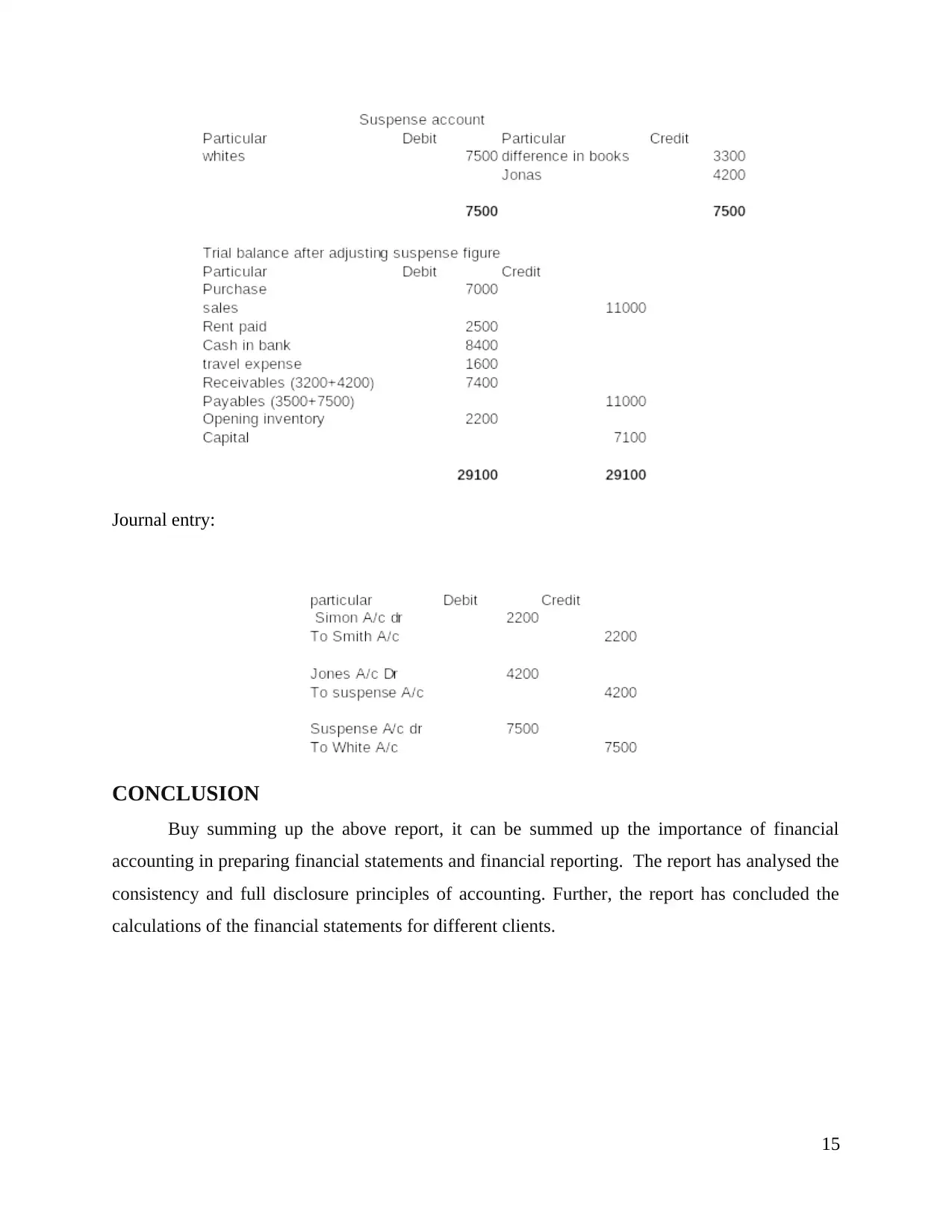
Journal entry:
CONCLUSION
Buy summing up the above report, it can be summed up the importance of financial
accounting in preparing financial statements and financial reporting. The report has analysed the
consistency and full disclosure principles of accounting. Further, the report has concluded the
calculations of the financial statements for different clients.
15
CONCLUSION
Buy summing up the above report, it can be summed up the importance of financial
accounting in preparing financial statements and financial reporting. The report has analysed the
consistency and full disclosure principles of accounting. Further, the report has concluded the
calculations of the financial statements for different clients.
15
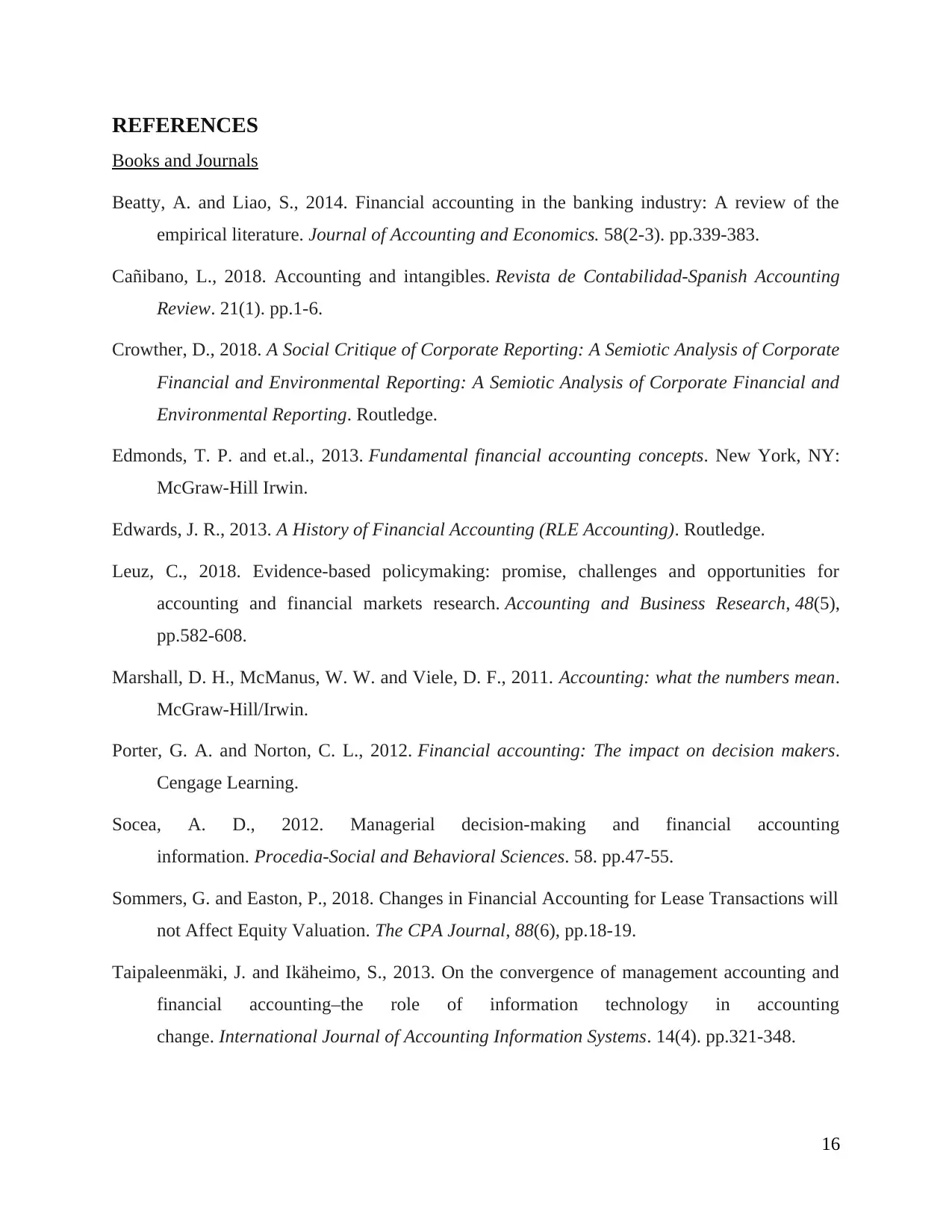
REFERENCES
Books and Journals
Beatty, A. and Liao, S., 2014. Financial accounting in the banking industry: A review of the
empirical literature. Journal of Accounting and Economics. 58(2-3). pp.339-383.
Cañibano, L., 2018. Accounting and intangibles. Revista de Contabilidad-Spanish Accounting
Review. 21(1). pp.1-6.
Crowther, D., 2018. A Social Critique of Corporate Reporting: A Semiotic Analysis of Corporate
Financial and Environmental Reporting: A Semiotic Analysis of Corporate Financial and
Environmental Reporting. Routledge.
Edmonds, T. P. and et.al., 2013. Fundamental financial accounting concepts. New York, NY:
McGraw-Hill Irwin.
Edwards, J. R., 2013. A History of Financial Accounting (RLE Accounting). Routledge.
Leuz, C., 2018. Evidence-based policymaking: promise, challenges and opportunities for
accounting and financial markets research. Accounting and Business Research, 48(5),
pp.582-608.
Marshall, D. H., McManus, W. W. and Viele, D. F., 2011. Accounting: what the numbers mean.
McGraw-Hill/Irwin.
Porter, G. A. and Norton, C. L., 2012. Financial accounting: The impact on decision makers.
Cengage Learning.
Socea, A. D., 2012. Managerial decision-making and financial accounting
information. Procedia-Social and Behavioral Sciences. 58. pp.47-55.
Sommers, G. and Easton, P., 2018. Changes in Financial Accounting for Lease Transactions will
not Affect Equity Valuation. The CPA Journal, 88(6), pp.18-19.
Taipaleenmäki, J. and Ikäheimo, S., 2013. On the convergence of management accounting and
financial accounting–the role of information technology in accounting
change. International Journal of Accounting Information Systems. 14(4). pp.321-348.
16
Books and Journals
Beatty, A. and Liao, S., 2014. Financial accounting in the banking industry: A review of the
empirical literature. Journal of Accounting and Economics. 58(2-3). pp.339-383.
Cañibano, L., 2018. Accounting and intangibles. Revista de Contabilidad-Spanish Accounting
Review. 21(1). pp.1-6.
Crowther, D., 2018. A Social Critique of Corporate Reporting: A Semiotic Analysis of Corporate
Financial and Environmental Reporting: A Semiotic Analysis of Corporate Financial and
Environmental Reporting. Routledge.
Edmonds, T. P. and et.al., 2013. Fundamental financial accounting concepts. New York, NY:
McGraw-Hill Irwin.
Edwards, J. R., 2013. A History of Financial Accounting (RLE Accounting). Routledge.
Leuz, C., 2018. Evidence-based policymaking: promise, challenges and opportunities for
accounting and financial markets research. Accounting and Business Research, 48(5),
pp.582-608.
Marshall, D. H., McManus, W. W. and Viele, D. F., 2011. Accounting: what the numbers mean.
McGraw-Hill/Irwin.
Porter, G. A. and Norton, C. L., 2012. Financial accounting: The impact on decision makers.
Cengage Learning.
Socea, A. D., 2012. Managerial decision-making and financial accounting
information. Procedia-Social and Behavioral Sciences. 58. pp.47-55.
Sommers, G. and Easton, P., 2018. Changes in Financial Accounting for Lease Transactions will
not Affect Equity Valuation. The CPA Journal, 88(6), pp.18-19.
Taipaleenmäki, J. and Ikäheimo, S., 2013. On the convergence of management accounting and
financial accounting–the role of information technology in accounting
change. International Journal of Accounting Information Systems. 14(4). pp.321-348.
16
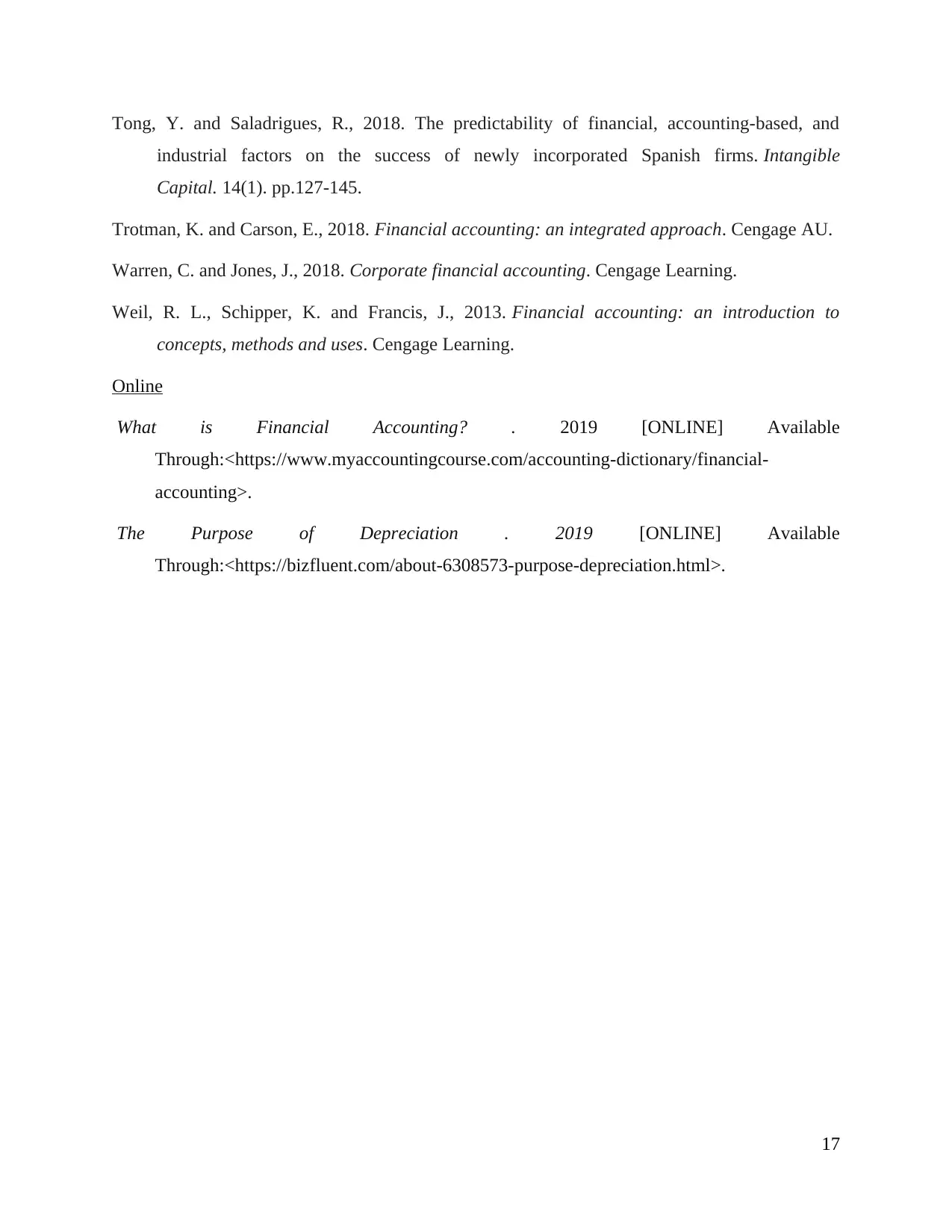
Tong, Y. and Saladrigues, R., 2018. The predictability of financial, accounting-based, and
industrial factors on the success of newly incorporated Spanish firms. Intangible
Capital. 14(1). pp.127-145.
Trotman, K. and Carson, E., 2018. Financial accounting: an integrated approach. Cengage AU.
Warren, C. and Jones, J., 2018. Corporate financial accounting. Cengage Learning.
Weil, R. L., Schipper, K. and Francis, J., 2013. Financial accounting: an introduction to
concepts, methods and uses. Cengage Learning.
Online
What is Financial Accounting? . 2019 [ONLINE] Available
Through:<https://www.myaccountingcourse.com/accounting-dictionary/financial-
accounting>.
The Purpose of Depreciation . 2019 [ONLINE] Available
Through:<https://bizfluent.com/about-6308573-purpose-depreciation.html>.
17
industrial factors on the success of newly incorporated Spanish firms. Intangible
Capital. 14(1). pp.127-145.
Trotman, K. and Carson, E., 2018. Financial accounting: an integrated approach. Cengage AU.
Warren, C. and Jones, J., 2018. Corporate financial accounting. Cengage Learning.
Weil, R. L., Schipper, K. and Francis, J., 2013. Financial accounting: an introduction to
concepts, methods and uses. Cengage Learning.
Online
What is Financial Accounting? . 2019 [ONLINE] Available
Through:<https://www.myaccountingcourse.com/accounting-dictionary/financial-
accounting>.
The Purpose of Depreciation . 2019 [ONLINE] Available
Through:<https://bizfluent.com/about-6308573-purpose-depreciation.html>.
17
1 out of 19
Related Documents
Your All-in-One AI-Powered Toolkit for Academic Success.
+13062052269
info@desklib.com
Available 24*7 on WhatsApp / Email
![[object Object]](/_next/static/media/star-bottom.7253800d.svg)
Unlock your academic potential
© 2024 | Zucol Services PVT LTD | All rights reserved.





